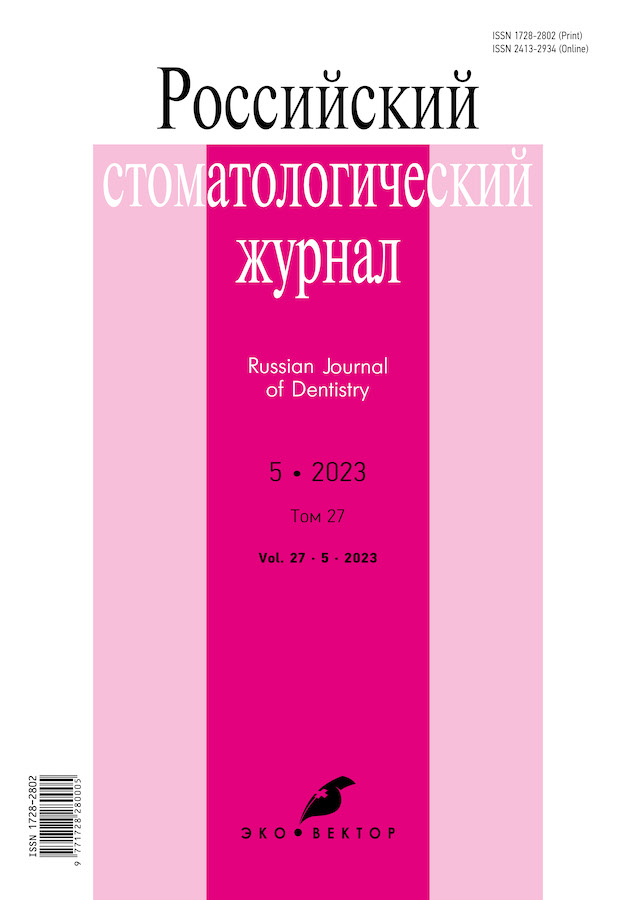Функциональное состояние височно-нижнечелюстного сустава у пилотов гражданской авиации и бортпроводников
- Авторы: Королькова К.В.1, Быкова М.В.1, Быков Д.О.2, Парунов В.А.1
-
Учреждения:
- Российский университет дружбы народов имени Патриса Лумумбы
- Московский государственный медико-стоматологический университет имени А.И. Евдокимова
- Выпуск: Том 27, № 5 (2023)
- Страницы: 443-449
- Раздел: Клинические исследования
- Статья получена: 22.06.2023
- Статья одобрена: 04.09.2023
- Статья опубликована: 04.12.2023
- URL: https://rjdentistry.com/1728-2802/article/view/501793
- DOI: https://doi.org/10.17816/dent501793
- ID: 501793
Цитировать
Полный текст
Аннотация
Обоснование. Пилоты гражданской авиации находятся в постоянном психологическом и физическом напряжении, в состоянии хронического стресса. Мы предполагаем, что хронический стресс и перегрузки негативно влияют на организм в целом и на зубочелюстную систему в частности, изменяя морфофункциональное состояние мышц челюстно-лицевой области и височно-нижнечелюстного сустава (ВНЧС).
Цель исследования — комплексное сравнительное изучение функционального состояния зубочелюстной системы пилотов и бортпроводников гражданской авиации, включающее клиническое обследование при помощи простого Гамбургского теста и звуковой вибрографии ВНЧС.
Материалы и методы. Было обследовано 30 пилотов гражданской авиации и 30 бортпроводников группы сравнения. Проведено стандартное клиническое обследование с применением простого Гамбургского теста и вибрографическое исследование ВНЧС на аппарате BioJVA из комплекса BioPAK (BioResearch, США).
Результаты. Гамбургский тест показал, что у пилотов выявлялись чаще, чем у бортпроводников, щелчки в суставе и травматическая эксцентрическая окклюзия. По результатам вибрографии у пилотов в два раза чаще отмечаются случаи с интегральным показателем свыше 80 ПаГц по сравнению с бортпроводниками, что свидетельствует о возможной патологии в ВНЧС.
Заключение. Клиническое обследование в сочетании с Гамбургским тестом и проведённой вибрографией показало, что у пилотов гражданской авиации гораздо чаще встречаются симптомы дисфункции ВНЧС по сравнению с группой бортпроводников.
Полный текст
Об авторах
Кристина Владимировна Королькова
Российский университет дружбы народов имени Патриса Лумумбы
Автор, ответственный за переписку.
Email: drkristinavdent@gmail.com
ORCID iD: 0000-0003-2982-0830
SPIN-код: 6667-8336
аспирант
Россия, 108811, Москва, ул. Диккенса, д. 7/3Марина Владимировна Быкова
Российский университет дружбы народов имени Патриса Лумумбы
Email: bykova_mv@mail.ru
ORCID iD: 0000-0003-0504-7767
SPIN-код: 9380-8298
кандидат мед. наук, доцент
Россия, 108811, Москва, ул. Диккенса, д. 7/3Денис Олегович Быков
Московский государственный медико-стоматологический университет имени А.И. Евдокимова
Email: 13dantist@mail.ru
ORCID iD: 0000-0003-4978-2608
SPIN-код: 4963-8000
кандидат мед. наук
Россия, МоскваВиталий Анатольевич Парунов
Российский университет дружбы народов имени Патриса Лумумбы
Email: vparunov@mail.ru
ORCID iD: 0000-0003-2885-3657
SPIN-код: 8797-6513
доктор мед. наук, профессор
Россия, 108811, Москва, ул. Диккенса, д. 7/3Список литературы
- Ушаков И.Б., Симакова Т.Г., Солдатов С.К., и др. Состояние твёрдых тканей зубов и содержание кальция и фосфора в биосубстратах у лётного состава // Военно-медицинский журнал. 2005. Т. 326, № 6. С. 51–53.
- Baldini A., Nota A., Cioffi C., Ballanti F., Tecco S. Mandibular position influence on pilots’ postural balance analyzed under dynamic conditions // Cranio. 2017. Vol. 35, N 6. P. 367–371. doi: 10.1080/08869634.2016.1271502
- Lurie O., Zadik Y., Einy S., et al. Bruxism in military pilots and non-pilots: tooth wear and psychological stress // Aviat Space Environ Med. 2007. Vol. 78, N 2. P. 137–139.
- Jacobus B.B. Flying personnel and occlusal/mandibular dysfunction // Aviat Space Environ Med. 1984. Vol. 55, N 2. P. 141–142.
- Ahlers M.O., Jakstat H.A. Klinische Funktionsanalyse: interdisziplinäres Vorgehen mit optimierten Befundbögen. Hamburg : Denta Concept, 2000.
- Gupta B., Thumati P., Radke J. Temporomandibular joint vibrations from totally asymptomatic subjects // Cranio. 2016. Vol. 34, N 3. P. 169–175. doi: 10.1179/2151090315Y.0000000013
- Kerstein R.B. Handbook of research on computerized occlusal analysis technology applications in dental medicine (2 volumes). Hershey : IGI Global, 2015. doi: 10.4018/978-1-4666-6587-3
- Гвасалия Л.В., Маленкина О.А. Экспресс диагностика заболеваний височно-нижнечелюстного сустава на первичном стоматологическом приёме // Dental Forum. 2011. № 3. С. 38.
- Федотова Т.М., Парунов В.А., Лебеденко И.Ю. Состояние височно-нижнечелюстного сустава профессиональных флейтистов по данным клинического обследования и вибрографии // Российский стоматологический журнал. 2022. Т. 26, № 2. С. 157–162. doi: 10.17816/1728-2802-2022-26-2-157-162
- Дубова Л.В., Мельник А.С., Ступников А.А., Савельев В.В. Сравнительная оценка показателей кинезиографии и электромиографии у пациентов без признаков патологии ВНЧС и с мышечно-суставной дисфункцией // Эндодонтия Today. 2016. Т. 14, № 2. С. 11–15.
- Ishigaki S., Bessette R.W., Maruyama T. Vibration of the temporomandibular joints with normal radiographic imagings: comparison between asymptomatic volunteers and symptomatic patients // Cranio. 1993. Vol. 11, N 2. P. 88–94. doi: 10.1080/08869634.1993.11677948
- Becker R.M. Joint Vibration Analysis (JVA). In: Information Resources Management Association, IGI Global, editors. Medical imaging: concepts, methodologies, tools, and applications. Hershey : IGI Global, 2017. P. 876–931. doi: 10.4018/978-1-5225-0571-6.ch036
Дополнительные файлы








